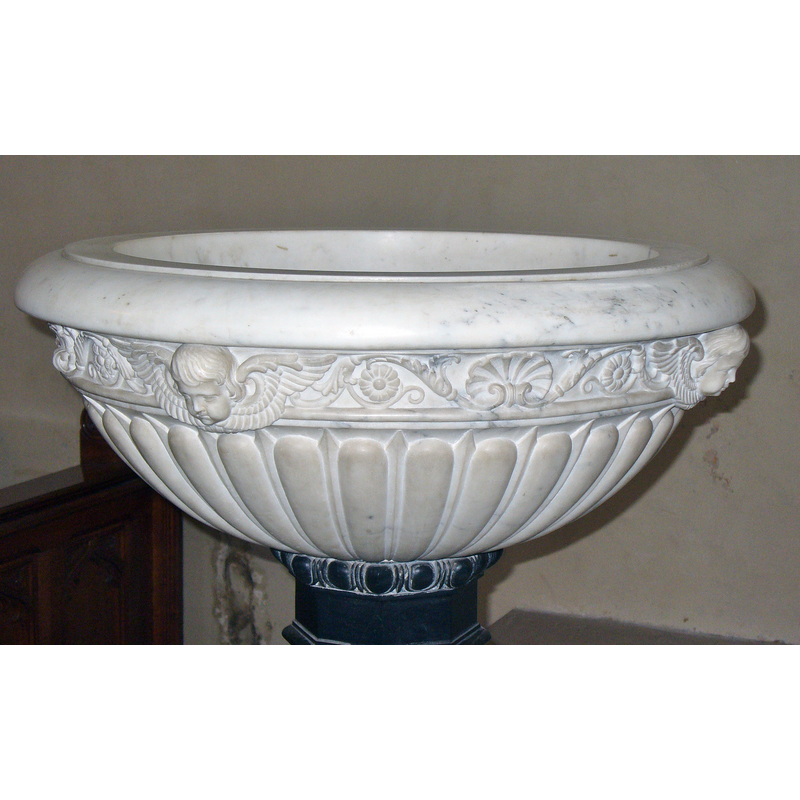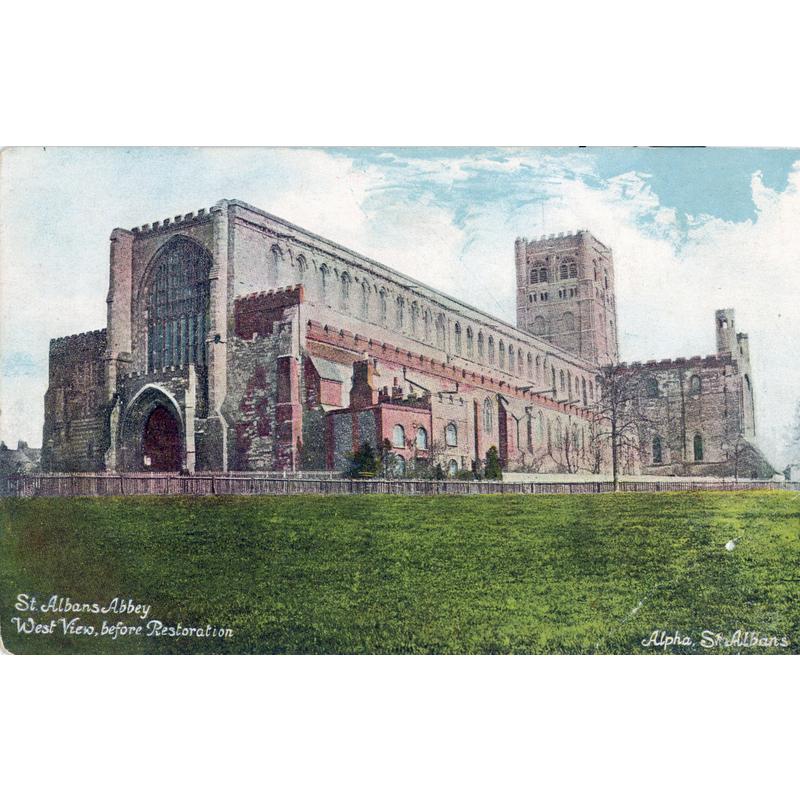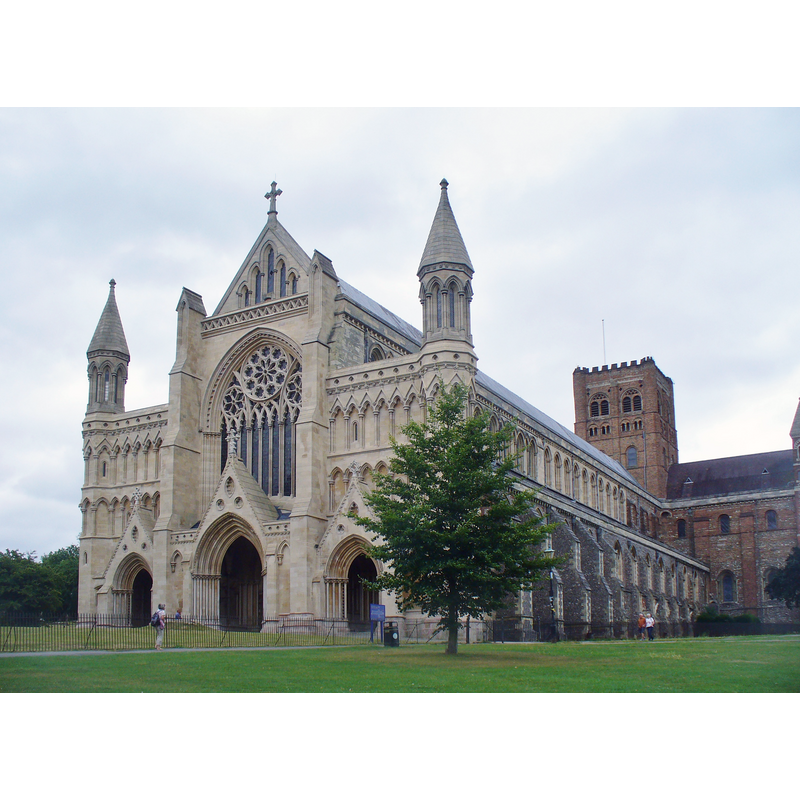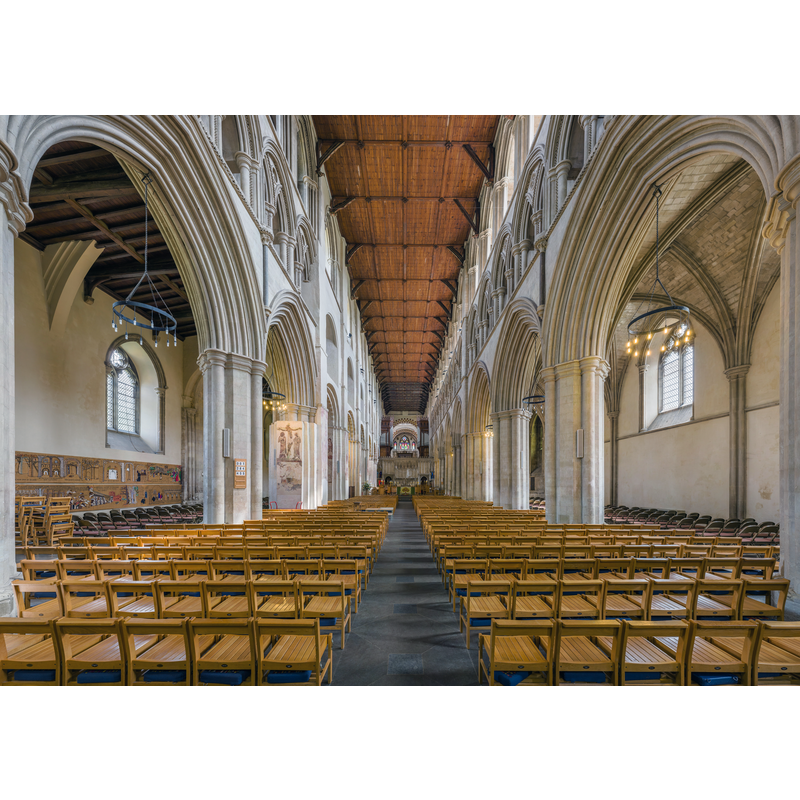St. Albans No. 1 / Villa S. Albani

Image copyright © Colin Smith, 2016
Image and permission received (e-mail of 3 November 2016)
Results: 6 records
view of basin
view of church exterior - southwest view
Scene Description: Source caption: "View of the West end of St Albans Abbey, St Albans, Hertfordshire, taken in about 1880 (before the restoration in the 1880s) and published as a post card in about 1905 by the Alpha Trading Company"
Copyright Statement: Image copyright © [in the public domain]
Image Source: digital image taken 312 October 2013 of a ca. 1905 postcard by the Alpha Trading Company [https://commons.wikimedia.org/wiki/File:St-albans-alpha-0002-abbey-west-end-old.jpg] [accessed 5 October 2016]
Copyright Instructions: PD US
view of church exterior - southwest view
view of church interior - nave - looking east
INFORMATION
FontID: 01081ALB
Object Type: Baptismal Font1
Church/Chapel: Cathedral and Abbey Church of St Alban [formerly St. Albans Abbey Church]
Church Patron Saints: St. Alban [aka Albanus]
Country Name: England
Location: Hertfordshire, East
Directions to Site: Located off the A5183, WNW of London
Ecclesiastic Region: Diocese of St. Albans
Historical Region: Hundred of St. Albans
Font Location in Church: disappeared ca. 1649?
Century and Period: 14th century, Decorated
Credit and Acknowledgements: We are grateful to Colin Smith for his photographs of this church and modern font
Church Notes: a church here is mentioned already in Bede (Cotton Nero D. VII, MS, British Library), later destroyed by the Saxons; replaced (?) by a later church ca. 793; raided by Danes; the 12thC abbey church built chiefly by Paul de Caen, first Norman abbot, was consecrated in 1115
Font Notes:
Click to view
There is an entry for St. Albans [variant spelling] in the Domesday survey [http://opendomesday.org/place/TL1407/st-albans/] [accessed 5 October 2016], but it mentions neither cleric nor church in it. A font here is noted in Camden's Britannia (1607) [cf. infra]. According to Simpson (1828) this font, now disappeared, was originally in the chapel at Holyrood Palace, Edinburgh, and was the font in which the children of the kings of Scotland were baptised. "In 1544 it was carried off by Sir Richard Lea, captain of the English pioneers and presented to the church of St. Albans; it was afterwards destroyed by the Roundheads." This metal font was supposedly made of brass or copper, although Andre (1882) notes: "A bronze font formerly existed at St. Alban's Abbey, but perished at the time of the Commonwealth" [i.e., 1649]. This same fate is noted in Britton's Dictionary of 1838: "it was destroyed by the Puritans". Forrest (1865) traces "the history of the brazen font". The background of the font and its circumstances are related in Galloway (1878-1879). The Victoria County History (Hertfordshire, vol. 2, 1908) mentions a font here only in a foot note related to the two eastern bays of the nave: "The font stood here till 1870, and this part of the church was known as the baptistery." The VCH entry further notes that there were parish functions within the abbey from early on: "The townsmen of St. Albans appear to have had rights in the abbey church at an early date and probably had their services in the nave of the Saxon church. When Paul de Caen, the first Norman abbot (1077–93), rebuilt the abbey church he appears to have provided for the wants of the lay folk by building the chapel of St. Andrew on the north of the nave. This chapel was rebuilt and enlarged in consequence of the alteration by Abbot John de Cella (1195–1214), and again rebuilt about 1454. St. Andrew's chapel served the same district as the present parish of St. Alban, formerly called St. Andrew's parish. The staff consisted of a vicar, usually called the warden, who took the lesser tithes, the abbot being rector. There were priests or chaplains to assist the vicar, varying in number from two at the beginning of the fifteenth century to four at the end of that century". A font here is listed in Bond (1908), after Simpson. Wall (1912) mentions that Camden's Britannia of 1586 spoke of "the brass font in which the children of the kings of Scotland used to be baptized, as standing in St. Albans Abbey Church in his day, bearing a Latin inscription by Sir Richard Lee. Wall (ibid.) also mentions that "Weaver testifies to its being in the church in 1631". Wall (ibid.) then quotes from Newcourt's Repertorium: "The brass Font at St. Albans was taken away by one Hickman, a vile ironmonger, a justice of the peace proper for those times." Wall (ibid.) finally quotes Fuller's Worthies (1662) about the replacement font: "There is a wooden one to supply its place, which is said to be made of the same shape with the old font". The present font appears to be a black and white marble vessel of classical line, a roughly hemispherical basin of white marble decorated with a few human heads at the upper rim, a gadrooned pattern all around the underbolw, on a quadrangular pedestal base of black marble.
COORDINATES
Church Latitude & Longitude Decimal: 51.750556, -0.342222
Church Latitude & Longitude DMS: 51° 45′ 2″ N, 0° 20′ 32″ W
UTM: 30U 683455 5736638
MEDIUM AND MEASUREMENTS
Material: metal, brass (bronze? / copper?)
INSCRIPTION
Inscription Language: Latin
Inscription Notes: Engl. Transl.: "WHEN LEETH, A TOWNE OF GOOD ACCOUNT AMONGT THE SCOTS, AND EDINBROUGH THEIR CHIEFE CITTIE WERE ON A FIRE, SIR RICHARD LEA KNIGHT SAVED MEE FROM BURNING, AND BROUGHT MEE INTO ENGLAND. AND I, BEING MINDFULL OF THIS SO GREAT A BENEFIT, WHEREAS BEFORE I WAS WONT TO SERVE THE BAPTISING OF NONE BUT KINGS CHILDREN, HAVE NOW WILLINGLIE OFFERED MY SERVICE EVEN TO THE MEANEST OF THE ENGLISH NATION. LEA THE VICTOUR WOULD HAVE IT SO. FAREWELL. IN THE YEARE OF OUR LORD MDXLIII AND OF THE REIGNE OF KING HENRIE THE EIGHTH XXXVI."
Inscription Location: unknown
Inscription Text: "CVM LAETHIA OPIDUM APVD SCOTOS NON INCELEBRE, ET EDINBVRGVS / PRIMARIA APVD EOS CIVITAS INCENDIO CONFLAGRARENT, RICHARDVS LEVS / EQVES AVRATVS ME FLAMMIS EREPTVM AD ANGLOS PERDVXIT. HVIVS EGO / TANTI BENEFICII MEMOR NON NISI REGVM LIBEROS LAVARE SOLITVS NVNC / MEAM OPERAM ETIAM INFIMIS ANGLORVM LIBENTER CONDIXI. LEVS VICTOR SIC / VOLVIT. VALE. ANNO DOMINI DMXLIIII ET ANNO REGNI HENRICI OCTAVI / XXXVI"
Inscription Source: Both Latin and English texts are from [http://www.philological.bham.ac.uk/cambrit/buckseng.html#herts13] [accessed 13 February 2009] [cf. FontNotes]
REFERENCES
Victoria County History [online], University of London, 1993-. Accessed: 2016-10-05 00:00:00. URL: https://www.british-history.ac.uk.
Victoria County History [online], University of London, 1993-. Accessed: 2016-10-05 00:00:00. URL: https://www.british-history.ac.uk.
Victoria County History [online], University of London, 1993-. Accessed: 2016-10-05 00:00:00. URL: https://www.british-history.ac.uk.
André, J. Lewis, "Leaden Fonts in Sussex", 32, Surrey Archaeological Collections, relating to the history and antiquities of the county, 1882
Bond, Francis, Fonts and Font Covers, London: Waterstone, 1985 c1908
Britton, John, A Dictionary of the Architecture and Archaeology of the Middle Ages, including […], London: Longman, Orne, Brown, Green, and Longmann, Paternoster Row, and the Author, Burton Street, 1838
Camden, William, Britannia [... with a translation by Philemon Holland], 1607
Cox, John Charles J., English Church Fittings Furniture and Accessories, London: B.T. Batsford, 1922
Forrest, George, An Account of the history and antiquities of St Leonard's, Edinburgh, its Chapel and Hospital, Edinburgh; London: MacLachlan & Stewart; Simpkin, Marshall, & Co., 1865
Galloway, William, "Notes on an ancient Scottish lectern of brass, now in the Parish Church of St Stephen's, St Albans, Hertfordshire", 13, Proceedings of the Society of Antiquaries of Scotland, 1878-1879, pp. 287-302; p. 288-301
Parker, John Henry, A Glossary of Terms used in Grecian, Roman, Italian and Gothic Architecture, Oxford: J. H. Parker, 1850
Simpson, Francis, A series of ancient baptismal fonts: chronologically arranged, drwan by F. Simpson, Jun., engraved by R. Roberts, London: Septimus Prowett, 1828
Tyrrell-Green, E., Baptismal Fonts Classified and Illustrated, London: Society for Promoting Christian Knowledge: The Macmillan Co., 1928
Wall, James Charles, Porches and Fonts, London: W. Gardner, Danton & Co., 1912
![[cf. Font notes]](/static-50478a99ec6f36a15d6234548c59f63da52304e5/others/image_not_available.jpg)
![[cf. Font notes]](/static-50478a99ec6f36a15d6234548c59f63da52304e5/bsi-testing-site/others/image_not_available.jpg)



